|
January 1949 Popular Science
 [Table of Contents] [Table of Contents]
Wax nostalgic about and learn from the history of early
electronics. See articles from
Popular
Science, published 1872-2021. All copyrights hereby acknowledged.
|
Having followed
advancements in all realms of astronomy - radio, microwave, infrared, visible
light, ultraviolet, x-ray, cosmic ray, etc. - all my memorable life, it is hard
to believe that anything other than visible wavelength (and near infrared and
near ultraviolet) observing was rare when this "Radio Telescope Creases New
Science" article appeared in a 1949 (barely) issue of Popular Science
magazine. That was less than a decade before I was born. Astronomers suspected,
but had not yet confirmed, that the universe emitted electromagnetic energy at
all wavelengths. Radio telescopes soon confirmed it. Not only has the science
and art of radio astronomy advanced considerably since 1949, but so, too, has
visible wavelength astronomy. To wit: The statement in the article accompanying
the star map declaring "You can see for yourself that there's nothing to see at
one of the points from which radio astronomers have heard noises..." has been
totally negated with the advent of the Hubbell Space Telescope, the James Web
Space Telescope, and several Earth-based mega-telescopes which have shown that
except where cosmic dust and/or gas obscures the view, stars fill virtually
every steradian of the sky if sensitive enough imagers are employed.
Radio Telescope Creates New Science
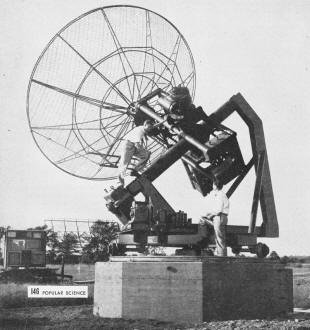
No dome shields Cornell's new telescope (below). It is built
For listening rather than looking.
Burps and hisses from parts of sky where nothing can be seen may clear up other
mysteries.
By Volta Torrey
Some of these days, a college catalogue may list a course like this:
Radio Astronomy. Fall term. Credit three hours. Mr. Whosis. The technique of
receiving, recording, and interpreting radio broadcasts from the sun and stars,
and the exploration of the invisible parts of the universe.
Soldiers and fliers, as well as astronomers and dreamers, may study this new
science. In their telescopes, amplifying tubes will serve as lenses, wire screens
as mirrors, and sounds instead of sights will be recorded. These radio telescopes,
which look like radar apparatus, will cost less than optical telescopes, but may
be far more useful. They are being developed now.
But no college has offered a course in radio astronomy yet, because this science
is too new. Its founders are still uncertain how to talk to each other.
Should they continue to call the noises that come out of their radio telescopes
"burps," "hisses," "bursts," "swishes," "grinds," etc.? Or should they coin new,
more precise terms? Or should they identify the various sounds by numbers or letters?
A committee to ponder this urgent problem was appointed recently when the pioneers
in radio astronomy conferred at Cornell University.
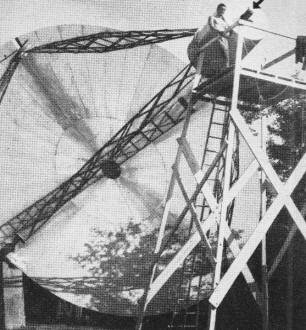
This picture of one of the first radio telescopes
appeared in PS a year ago (Jan. '48, p. 150). It was built by Grote Reber, a ham
from Wheaton, Ill., now a Bureau of Standards radio physicist. Note how different
it looks from new Cornell model on facing page.
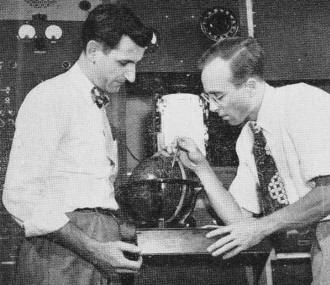
On a celestial globe, Prof. Charles S. Seeger
indicates to William E. Gordon (left) the Sagittarius region, which produces the
strongest radio "noise" broadcast from the Milky Way.
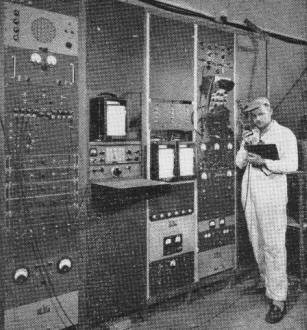
Noise from stars comes out of loudspeaker at
top left in Cornell radio-astronomical observatory. Sound variations too small to
hear are recorded on rolls of paper in center of board.
Cornell is the first American university to build a radio-astronomical observatory.
Two other U. S. stations, three in England, three in France, one in Canada, and
one in Australia are also trying to decipher the chatter of the sun and stars. The
Russians may be listening in, too.
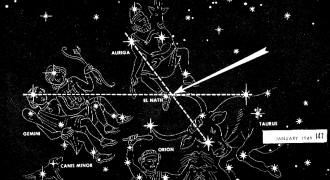
You can see for yourself that there's nothing to see at one of
the points from which radio astronomers have heard noises. Step outside any clear
night and find El Nath (below). The area just west of this star is one of those
points. Between 9 and 10 p.m. at this time of year, El Nath is slightly to the south
of a point overhead for most observers in the United States.
The Australians have found that even parts of the sky" in which nothing can be
seen are making noises, How? And why? Nobody knows.
"This business," says one of the young engineers at Cornell, "gives a fellow
a good idea of how Galileo must have felt."
You don't have to be much of a seer, however, to see that more knowledge of radio
astronomy might be very helpful, pronto.
Suppose, for example, that some nation were planning a long-range bombing attack.
The results would depend pretty largely on the performance of radio and radar apparatus.
That, in turn, would depend on the sun. It shoots out particles that disturb the
ionosphere from time to time, and those disturbances raise hob with radio and radar
systems.
But the sun also broadcasts sounds that the radio telescopes pick up. These radio
waves span the 93,000,000 miles from the sun to the earth as fast as light-and arrive
several hours ahead of the particles that make the ionosphere play tricks on the
communications experts.
Are the radio waves warning signals from the sun? Can they be interpreted? Will
they tell us when our radars will work and when they won't?
When put on a loudspeaker, the broadcasts from the sun make it hiss and occasionally
pop. When recorded on a moving strip of paper, these sounds produce a long, kinky
line. That sound track may some day be as helpful to communications engineers as
an animal's tracks are to a hunter.
But, to learn to read this kind of writing, the scientists need continuous records
of the sun's broadcasts. These cannot be compiled by anyone receiving station: three
or four stations on different sides of the world will have to cooperate. Each one
will have to focus its antenna on the sun for so many hours, then pass the assignment
on to the next station like a runner in a relay race. Timing, apparatus, and methods
of comparing findings must be agreed on beforehand.
The new radio telescope at Cornell works very much like a big optical telescope.
The reflector of this hearing aid is 4 inches wider than the 200-inch mirror of
the big "eye" on Mt, Palomar. This sound mirror, however, is transparent. It is
simply a wire screen, shaped like a saucer. This screen focuses the radiation from
afar on a tiny antenna that protrudes from the center of the dish.
The big saucer and antenna are mounted so that they can be kept directed at the
sun, a star, or a "ghost" broadcasting area while it crosses the sky. The ear turns
automatically, the same way that big optical telescopes track the objects they wish
to keep in view.
There are two definite advantages to listening to the stars through such an ear,
rather than looking at them through optical lenses. The radiation that the radio
telescopes pick up extends over three times as much of the electromagnetic spectrum
as does visible light. This means, in effect, that it's possible to hear what's
happening in the heavens through a window three times as big as the one that we
see through. The second wonderful thing about this radiation is that it is not shut
out, the way the light from the stars is, by passing clouds. This means that radio
telescopes can be used on the darkest, stormiest night. The one at Cornell is built
to withstand winds up to 60 miles an hour.
Moreover, Cornell's big ear cost only one-half of one per cent as much as California's
big eye. Which will prove to be the better investment depends on what the stars
are saying and how soon the scientists learn their language.
Posted April 30, 2024
|














